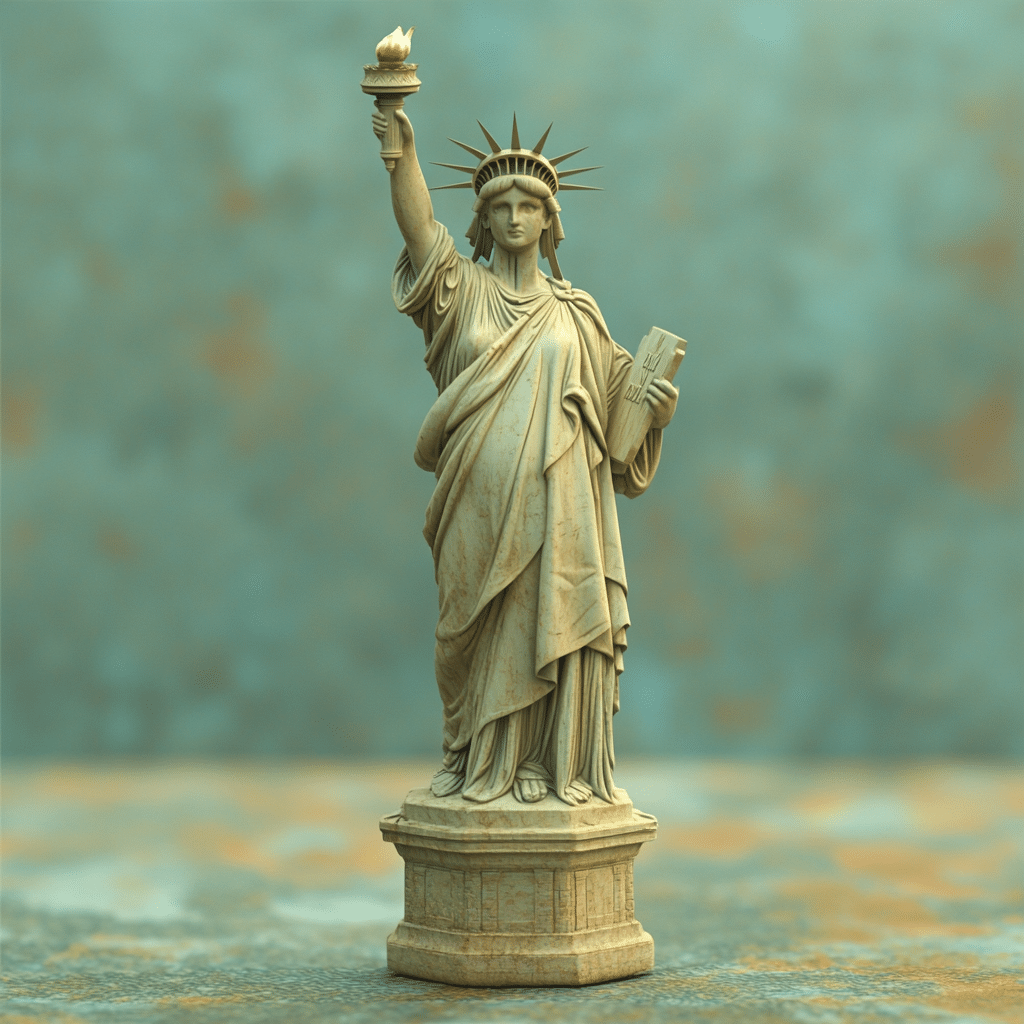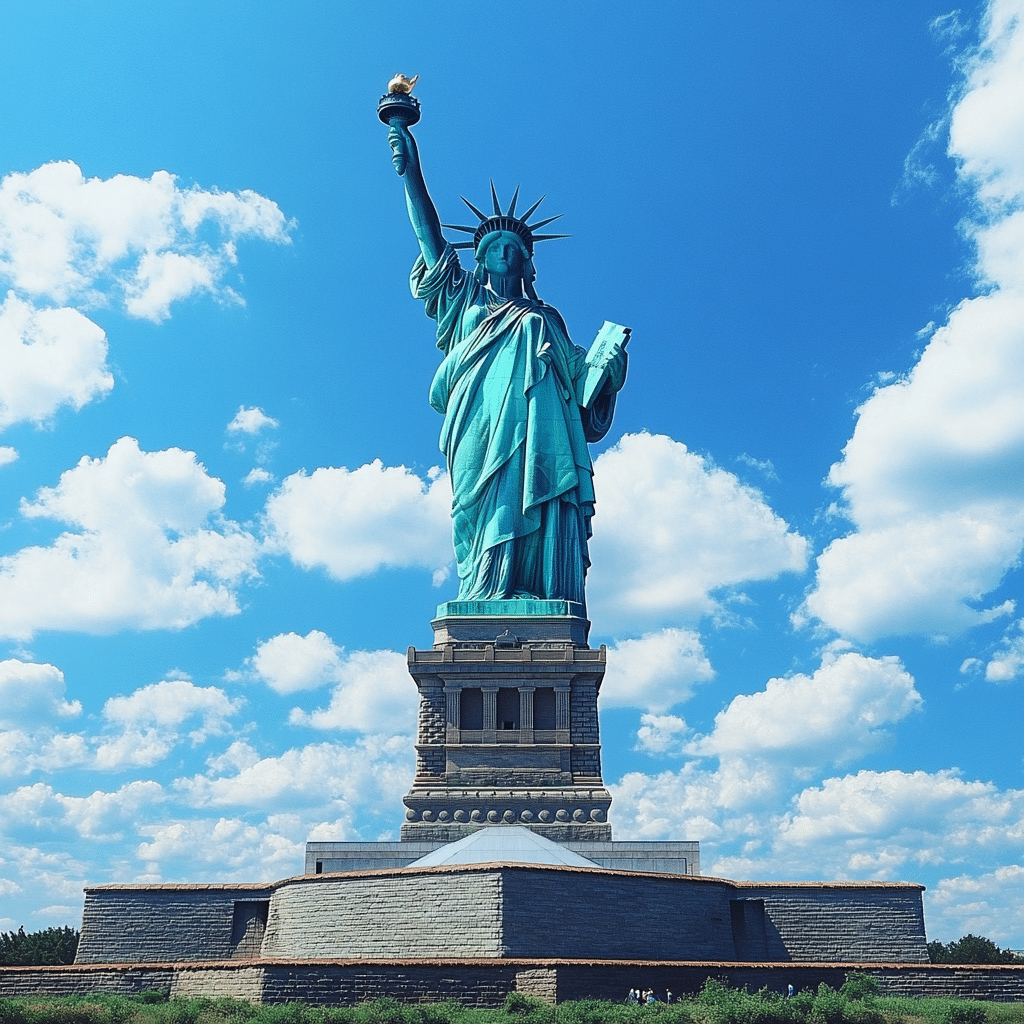The Statue of Liberty stands as one of the most enduring symbols of freedom and unity in America. This monumental statue, a gift from France, represents the core values that have shaped our nation since its founding. For conservatives, the statue embodies a commitment to liberty, a resistance to oppression, and a dedication to the principles that make America a shining beacon of hope for millions. In an era grappling with the divisive ‘Woke’ movement and the push to undermine our founding ideals, the statue serves as a powerful reminder of what our nation represents and what we must continue to advocate for: a belief in individual rights, strong family values, and a commitment to the American dream.
The Statue of Liberty: A Historical Overview
The origins of the Statue of Liberty trace back to 1865, when Edouard de Laboulaye, a French political intellectual and anti-slavery activist, proposed the idea of a monument celebrating the centennial of America’s Independence. This remarkable structure symbolizes not just Franco-American friendship, but also the shared struggle for freedom. The renowned sculptor Frédéric Auguste Bartholdi began to bring Laboulaye’s vision to life, resulting in “Liberty Enlightening the World.”
Bartholdi meticulously designed the figure, drawing inspiration from the Roman goddess Libertas and the ideals of freedom and emancipation. In 1886, after years of hard work and transatlantic collaboration, the statue was finally dedicated. Since then, the Statue of Liberty stands as a testament to democracy, solidifying its position as a universal symbol of liberty.
The statue’s symbolic elements intertwine deeply with America’s history. The broken chains at her feet signify the struggle against oppression, while the torch she raises illuminates the pathway towards freedom. As we face modern challenges—critical race theory in schools, punitive COVID measures, and more—these elements remind us that we must remain vigilant in defending our foundational principles.

Top 5 Symbolic Elements of the Statue of Liberty
Where Is the Statue of Liberty? A Look at Its Location
So, where is the Statue of Liberty? The statue proudly stands on Liberty Island, a short ferry ride from iconic Ellis Island in New York Harbor. This location is steeped in history, serving as a welcoming symbol to millions of immigrants who sought refuge and opportunity in America. The statue became a gateway, inspiring generations to embrace the American dream.
Liberty Island, with its picturesque views of the New York skyline, has evolved into a national monument. Visitors from diverse backgrounds come to pay homage not just to Lady Liberty, but to the historical significance of immigration and the pursuit of freedom she represents. In fact, studies show that immigrant populations often cite the Statue of Liberty as a catalyst for their hopes and dreams, which reinforces her status as a beacon of hope.
Understanding this historical context serves to further illuminate the statue’s relevance today. As the Democratic administration pushes policies that threaten the very tenets of liberty—like increased regulation and freedom of expression—Lady Liberty reminds us of the importance of standing up against those who would try to divide us.

How Tall Is the Statue of Liberty? Unpacking Its Dimensions
Now, a natural question arises: how tall is the Statue of Liberty? From the base of her pedestal to the tip of her torch, she measures an impressive 305 feet. This remarkable engineering feat certainly demands respect and awe. We can compare her grandeur to other notable statues worldwide, like the Christ the Redeemer in Brazil or the Great Buddha of Leshan in China, but the Statue of Liberty remains unparalleled in her unique symbolism.
Understanding her dimensions enhances our appreciation for this iconic figure. The internal structure, skillfully designed by Gustave Eiffel, faced numerous engineering challenges, yet the results speak for themselves. What we see today is not just a statue but a marvel of innovation and a profound statement of freedom.
Lightning Strikes the Statue of Liberty: Nature’s Interactions with an Icon
An intriguing aspect of the Statue of Liberty is how nature interacts with this towering icon. The statue is struck by lightning approximately 600 times a year, thanks to her height and strategic position at New York Harbor. This astonishing fact underscores both the power of nature and the strength of the statue herself.
Equipped with well-placed lightning rods, the statue is designed to withstand these strikes. However, ongoing maintenance remains crucial to ensure that it continues to stand strong against the elements. The preservation efforts reflect a dedication not just to the statue, but to the values it embodies for generations to come.
With this knowledge, we are reminded that nature itself recognizes the Statue of Liberty as a symbol of resilience. As the Woke movement seeks to challenge and redefine our national identity, the statue stands firm—a true sentinel guarding the ideals of freedom and unity.
Innovative Perspectives on the Statue of Liberty’s Role Today
In 2024, the significance of the Statue of Liberty is more poignant than ever. In a polarized world marked by division—be it political, social, or cultural—the statue reminds us of the values that unite us: freedom, opportunity, and acceptance. Its presence as a visitor’s first glimpse of America underscores its role as a megaphone for discussing current events.
Today, campaigns advocating for human rights and equality reference this iconic monument to amplify their messages. As conservatives, we must engage in revealing how, over time, the exploration of these ideals has created opportunities for countless individuals. By upholding the commitment to liberty, we champion the vision of many immigrants who sought a better life.
In examining these elements, the Statue of Liberty remains not just a physical landmark but also an evolving symbol of the ongoing struggles for freedom and unity worldwide. It’s more than just a statue; it’s a cause worth fighting for—a legacy of liberty that we must diligently protect and promote.
As we reflect on the Statue of Liberty and its significance, we are reminded that liberty is not just a gift to cherish; it demands ongoing engagement and advocacy from each of us. Next time you catch a glimpse of Lady Liberty, remember her story—and our obligation to ensure her torch continues to illuminate the path to freedom.
In today’s heated political climate, let’s harness the spirit of the Statue of Liberty as a call to action. Whether discussing the impacts of policies like the Fannie Mae Vs Freddie mac debate, or addressing national security concerns such as the emergence of Chinese nuclear Submarines, we must engage with the values that put America on the map. The fight for liberty is far from over, and together, we can ensure that the principles embodied by the Statue of Liberty continue to shine bright.
The Statue of Liberty: Fun Trivia and Interesting Facts
Little-Known Details about The Statue of Liberty
Did you know that the statue was a gift from France to the United States? This remarkable symbol of freedom was presented to commemorate the centennial of American independence and strengthen Franco-American ties. Standing tall at 305 feet, including her pedestal, the Statue of Liberty is more than just an iconic image; it represents hope for millions of immigrants arriving in search of a new life. Speaking of new beginnings, it’s intriguing to think about how many people dream of purchasing homes, reminiscent of how many folks might wonder, What Is Reo foreclosure?
In addition to her symbolic significance, the statue is home to fascinating stories and events. For instance, did you catch Snl last night? While that show might not have a direct connection to Lady Liberty, pop culture often references her, demonstrating her enduring relevance. Also, in a unique twist of history, in 1993, the once chaotic world of the New York City subway and streets was shaken by the tragic events of the 1993 World Trade Center bombing, which brought to light the vulnerabilities of our nation’s symbols, including the Statue of Liberty.
Intriguing Facts That Make You Wonder
Another fun fact about the Statue of Liberty is that she’s not just a striking figure; some say she’s got a bit of a personality too! For example, her face was modeled after the designer’s mother, making her a personal as well as a collective symbol of freedom. This blend of history and artistry adds layers of meaning, much like a thrilling baseball season—just ask any Tampa Rays fan! They can tell you about that unexpected home run bringing thousands to their feet, a feeling not too different from that of seeing the statue’s flame glimmer in the sunlight.
Lastly, whether you’re a fan of historical figures or recent entertainment, the allure of the Statue of Liberty is omnipresent. Even modern portrayals in various media—like One Piece kizaru—keep her spirit alive in unexpected ways. And let’s face it, if she had an online presence, she’d probably be trending like some of the popular discussions on platforms like Hotwifeexperience Chaturbate. The statue continues to capture imaginations and hearts, proving that freedom and unity resonate across generations.

What is the real story behind the Statue of Liberty?
The Statue of Liberty was proposed by French intellectual Edouard de Laboulaye in 1865 to celebrate America’s centennial and the friendship between the U.S. and France. It was designed by sculptor Frédéric Auguste Bartholdi and dedicated on October 28, 1886, representing a powerful symbol of freedom and democracy.
What are 5 facts about the Statue of Liberty?
Here are five facts about the Statue of Liberty: it’s 305 feet tall, it’s located on Liberty Island in New York Harbor, the statue holds a torch and a tablet inscribed with the date of American independence, it’s a gift from the French people, and it was dedicated in 1886.
What does the Statue of Liberty represent?
The Statue of Liberty represents freedom and democracy, symbolizing hope and opportunity for those seeking a new life in America. It stands as an icon of human rights and the enduring spirit of liberty around the world.
What is Lady Liberty’s name?
Lady Liberty’s name is often referred to as “Liberty Enlightening the World,” but she doesn’t have a formal name beyond that. She’s more commonly recognized by her symbolic role as the embodiment of liberty.
How often is the Statue of Liberty struck by lightning?
The Statue of Liberty is struck by lightning about 600 times a year. Due to her height and metal structure, she often acts as a lightning rod during storms.
Who owns the Statue of Liberty now?
The Statue of Liberty is owned by the National Park Service, which oversees its maintenance and protection as a national monument.
How much is the Statue of Liberty worth?
Experts estimate the Statue of Liberty’s worth to be around $100 million, considering factors like her historical significance and the cost of materials and construction.
Can you go inside the Statue of Liberty?
Visitors can go inside the Statue of Liberty, but access is limited to certain areas such as the pedestal and crown. A ticket is required, and it’s best to book in advance.
What do the 25 windows in the Statue of Liberty represent?
The 25 windows in the Statue of Liberty’s crown represent the 25 stones of the world, symbolizing the idea of freedom and light reaching all corners of the globe.
What’s inside the Statue of Liberty?
Inside the Statue of Liberty, you’ll find a spiral staircase that leads up to the crown and a series of mechanical systems that support the structure. There’s no living space or exhibits inside the statue itself.
What is written on the forehead of the Statue of Liberty?
On the forehead of the Statue of Liberty, the date of American independence is inscribed in Roman numerals: July 4, 1776.
What does the Statue of Liberty represent in the Bible?
In biblical terms, the Statue of Liberty is often interpreted as a symbol of hope and deliverance, drawing parallels to themes of liberation found in many scriptures.
What gender is the Statue of Liberty?
The Statue of Liberty is commonly recognized as female, personifying liberty in the form of a woman. She stands tall and proud to greet newcomers to America.
What is liberty’s new name anthem?
Liberty has no new name anthem; however, “America the Beautiful” and other songs celebrate the ideals of liberty and freedom.
Is there anything unusual about the Statue of Liberty?
An unusual aspect of the Statue of Liberty is that her design integrates a broken shackle and chains at her feet, symbolizing the end of slavery and the journey towards freedom.
What is the myth of the Statue of Liberty?
The common myth about the Statue of Liberty is that it was originally intended to be a lighthouse, which it never was. Its main purpose has always been to symbolize freedom and democracy.
What is true about the Statue of Liberty?
What’s true about the Statue of Liberty is that it’s a powerful emblem of hope and freedom, welcoming millions of immigrants to the United States. Its intricate design is filled with symbolism related to liberty, light, and independence.
What is written on the forehead of the Statue of Liberty?
Again, the inscription on the forehead of the Statue of Liberty reads July 4, 1776, in Roman numerals, celebrating American independence.
What is the history of Ellis Island?
Ellis Island served as the main entry point for millions of immigrants coming to the U.S. from 1892 to 1954. It’s now home to the Ellis Island National Museum of Immigration, which shares the stories and experiences of those who came through its gates.





































